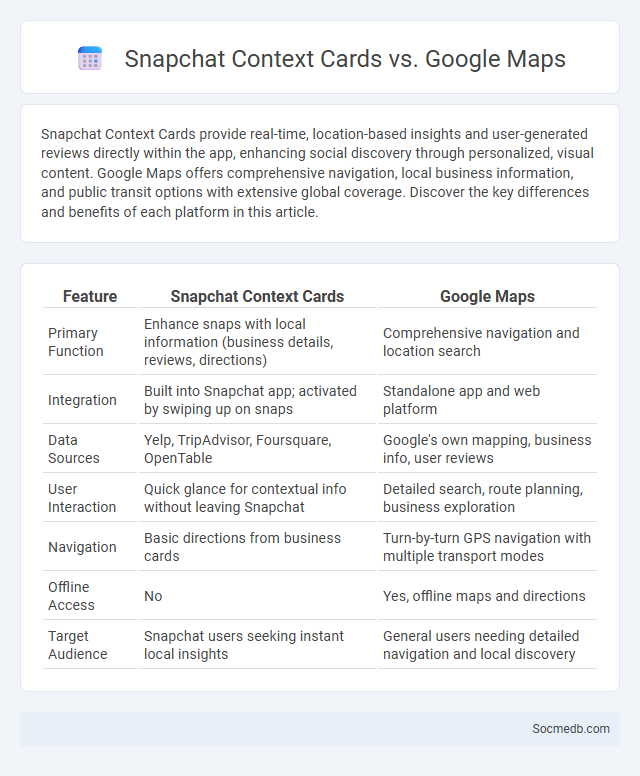
Photo illustration: Snapchat Context Cards vs Google Maps
Snapchat Context Cards provide real-time, location-based insights and user-generated reviews directly within the app, enhancing social discovery through personalized, visual content. Google Maps offers comprehensive navigation, local business information, and public transit options with extensive global coverage. Discover the key differences and benefits of each platform in this article.
Table of Comparison
| Feature | Snapchat Context Cards | Google Maps |
|---|---|---|
| Primary Function | Enhance snaps with local information (business details, reviews, directions) | Comprehensive navigation and location search |
| Integration | Built into Snapchat app; activated by swiping up on snaps | Standalone app and web platform |
| Data Sources | Yelp, TripAdvisor, Foursquare, OpenTable | Google's own mapping, business info, user reviews |
| User Interaction | Quick glance for contextual info without leaving Snapchat | Detailed search, route planning, business exploration |
| Navigation | Basic directions from business cards | Turn-by-turn GPS navigation with multiple transport modes |
| Offline Access | No | Yes, offline maps and directions |
| Target Audience | Snapchat users seeking instant local insights | General users needing detailed navigation and local discovery |
Introduction to Contextual Discovery Tools
Contextual discovery tools analyze user behavior, preferences, and interactions on social media platforms to deliver personalized content and advertisements. These tools leverage AI algorithms and vast data sets to enhance user engagement by presenting relevant posts, products, or services based on real-time context. By integrating contextual discovery into your social media strategy, you can significantly improve content relevance and user experience.
What Are Snapchat Context Cards?
Snapchat Context Cards provide users with detailed information about locations, businesses, and events linked to Snaps, enhancing your experience by offering insights such as hours of operation, reviews, contact details, and directions. These cards leverage partnerships with services like TripAdvisor, OpenTable, and Foursquare to present real-time updates and recommendations within the app. Using Context Cards, you can quickly explore and engage with the world around you without leaving Snapchat.
Overview of Google Maps Features
Google Maps offers comprehensive navigation tools including real-time GPS tracking, turn-by-turn directions, and traffic condition updates. The platform integrates user-generated content such as reviews, photos, and business information to enhance local discovery. Advanced features include Street View, indoor maps, and offline access, optimizing user experience for both everyday commutes and travel planning.
Comparing User Experiences
User experiences on social media platforms vary significantly based on interface design, content algorithms, and community engagement features. Platforms like Instagram prioritize visual storytelling with algorithm-driven feeds, enhancing discovery but sometimes limiting chronological content flow. In contrast, Twitter emphasizes real-time updates and public conversations, fostering immediate interaction but presenting challenges in content moderation and information overload.
Data Sources and Accuracy
Data sources for social media analytics include user-generated content, platform APIs, and third-party data aggregators, ensuring a diverse and comprehensive dataset. Accuracy depends on real-time data extraction, rigorous filtering of spam or bots, and validation against verified user information to maintain integrity. Your analysis benefits from leveraging multi-source validation techniques to enhance the reliability of social media insights.
Interactivity and Engagement
Social media platforms drive high interactivity by enabling real-time communication, content sharing, and user feedback through likes, comments, and shares, fostering dynamic community engagement. Features like live streaming, polls, and interactive stories increase user participation and brand interaction, enhancing overall engagement metrics. Algorithms prioritize content with high interaction rates, boosting visibility and encouraging consistent user activity on the platform.
Location-Based Social Sharing
Location-based social sharing enhances your social media experience by allowing you to connect with others nearby and discover real-time local trends, events, and popular spots. Platforms like Instagram, Facebook, and Snapchat use geotagging and check-ins to provide personalized content based on your geographic location. Leveraging location data boosts engagement and helps you build a community rooted in shared physical experiences.
Business Integration and Partnerships
Social media platforms serve as powerful tools for business integration and partnerships by enabling seamless collaboration across diverse industries and global markets. Leveraging APIs and cross-platform functionalities, companies can synchronize marketing campaigns, share resources, and co-create content to enhance brand visibility and customer engagement. You can maximize your business growth by strategically utilizing these integrated social networks to foster long-term partnerships and unlock new revenue streams.
Privacy and User Control
Social media platforms have increasingly implemented advanced privacy settings to empower users with greater control over their personal data. You can customize visibility options, manage data sharing preferences, and utilize tools like two-factor authentication to enhance account security. Prioritizing these privacy features ensures a safer online experience while maintaining your digital presence.
Future Trends in Contextual Location Services
Future trends in contextual location services on social media emphasize hyper-personalized user experiences driven by AI and real-time geospatial data. Enhanced integration of augmented reality (AR) with location-based content will enable immersive social interactions tailored to users' immediate environment. Advances in privacy-preserving technologies will balance precise location targeting with stricter data protection regulations, reshaping how brands engage local audiences.
 socmedb.com
socmedb.com